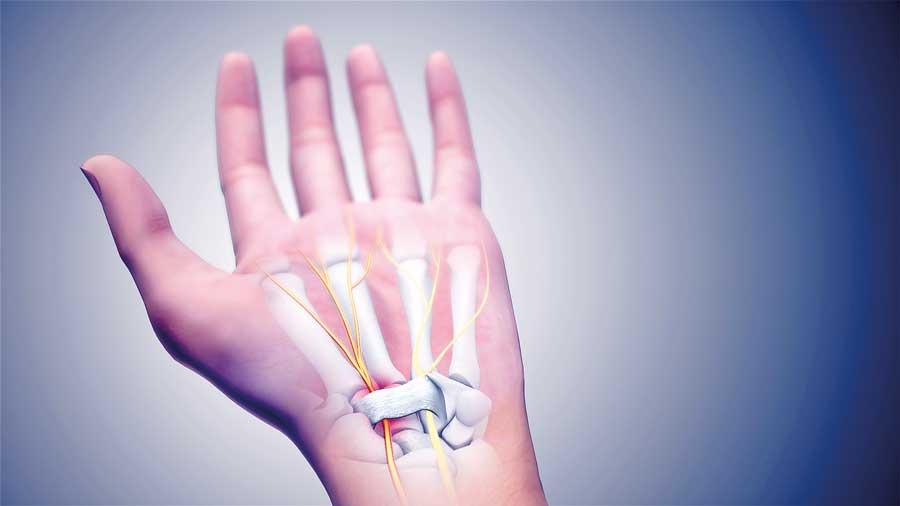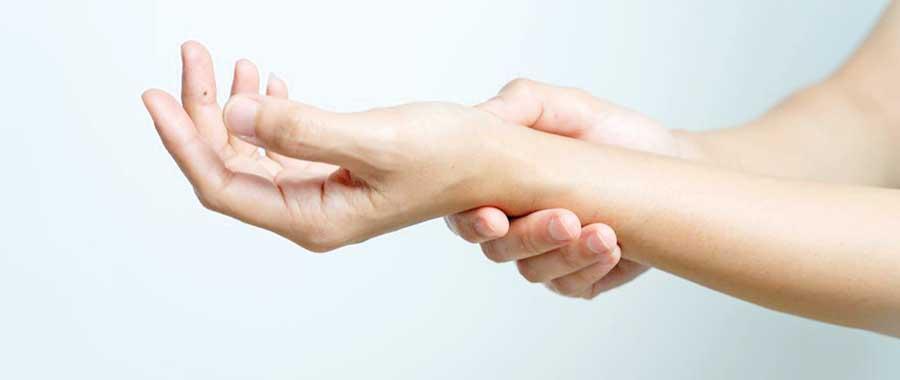08 Nov 2019 - {{hitsCtrl.values.hits}}

 The human hand is made up of bones in the wrist (carpal bones), small muscles attached to the bones (digits) of the fingers, nerves and blood vessels.
The human hand is made up of bones in the wrist (carpal bones), small muscles attached to the bones (digits) of the fingers, nerves and blood vessels.
Together these structures help in all hand movements such as grasping, holding, writing etc.
However, damage or change to one of these structures can greatly affect the flexibility and quality of work done by the hand.
Carpal tunnel syndrome (CTS) is one such disease that affects the hand and the wrist while limiting any activity that involves the hand.
Carpal tunnel syndrome is a common condition that occurs in the hand due to the compression of a nerve called ‘median nerve’ inside the carpal tunnel. The carpal tunnel is a narrow passageway on the wrist which is surrounded by wrist bones and a rigid ligament that holds the bones together. While the tendons of the fingers and thumb run through this tunnel, it also makes space for the median nerve to carry the signals from the brain to control the motion of the fingers and hand.
CTS is a condition that can be developed easily and spontaneously. However, there is very little awareness and concern about the disorder. The Health Capsule spoke to Dr. Lalindra Dias, Consultant Physician at the District General hospital, Nuwara Eliya, in order to help shed light on the seriousness of such an easily affected disease.
WHAT IS CARPAL TUNNEL SYNDROME?
Dr. Lalindra Dias stated that Carpal tunnel syndrome is a condition that occurs in the hand due to compression of the median nerve within the carpal tunnel. He explained that the median nerve supplies small muscles in our hand which further continue into the fingers.
The median nerve travels through a tunnel in the wrist area of the hand called the ‘carpal tunnel’ which is made out of fibrous bands.
Dr. Dias explained that in some people, the nerve can get compressed within the tunnel causing abnormal sensations in the fingers, particularly the thumb and second, third and fourth fingers. This condition is known as the ‘carpal tunnel syndrome’.
CAUSES FOR CARPAL TUNNEL SYNDROME
According to Dr. Dias, the causes for CTS include diabetes, lack of thyroxin (hypothyroidism), rheumatoid arthritis, retention of fluid during pregnancy, fractures to the wrist and some other complicated medical conditions.
SYMPTOMS OF CARPAL TUNNEL SYNDROME
Dr. Dias mentioned that the symptoms of CTS include numbness and a ‘pins and needles’ sensation in the fingers. These symptoms are usually known to arise in the thumb and the first three fingers of the affected hand.
These conditions can also interfere with sleep and cause pain and burning that travel up in the arm.
COMPLICATIONS OF CTS
Dr. Dias explained that CTS can cause complications such as being unable to perform the normal activities done by the hand.
Therefore, it can cause patients to drop items such as plates, cups and saucers etc. Dr. Dias further stated that most patients tend to complain about the weakness of the thumb which causes difficulty in writing, drawing etc.
Furthermore, it can limit their daily activities such as opening taps, using cutlery and combing hair due to the inability to move the hand.
CTS patients lose their firm grip due to the weakness of the muscles at the base of the thumb.
“The nerve goes down to the fingers. That is why when the nerve in the wrist gets compressed, you get numbness in the fingers,” Dr. Dias stated.

DIAGNOSIS OF CTS
Dr. Dias said that when consulting a GP, an examination of the wrist and fingers should be conducted in order to test the sensations of the affected hand.
After the examination, the patient will have to meet with a neuro-electrophysiologist who will conduct a nerve conduction study and confirm the CTS.
TREATMENT FOR CTS
Dr. Dias stated that pain relief medication analgesic is prescribed for the very initial stages of CTS. Non steroids and anti-inflammatory medications are also provided to the CTS patient.
Dr. Dias further mentioned that for some patients, a short course of steroids is given to suppress the inflammation. Steroids can also be injected to the surrounding area of the wrist.
If all above medications fail, surgery is conducted as a definitive treatment. Surgery includes ‘relief surgery’ which is done by a small cut with local anesthesia.
PREVENTION OF CTS
Although CTS is a disorder that can be caused spontaneously and cannot be prevented, Dr. Dias advised tight control of the blood sugar levels in diabetes patients can help to prevent people with diabetes from getting CTS.
“If you develop any symptoms mentioned above in your hand, it is most advisable to consult your GP rather than attending to local home remedies,” Dr. Dias said.
21 Dec 2024 21 Dec 2024
21 Dec 2024 21 Dec 2024
21 Dec 2024 21 Dec 2024
21 Dec 2024 21 Dec 2024
21 Dec 2024 21 Dec 2024